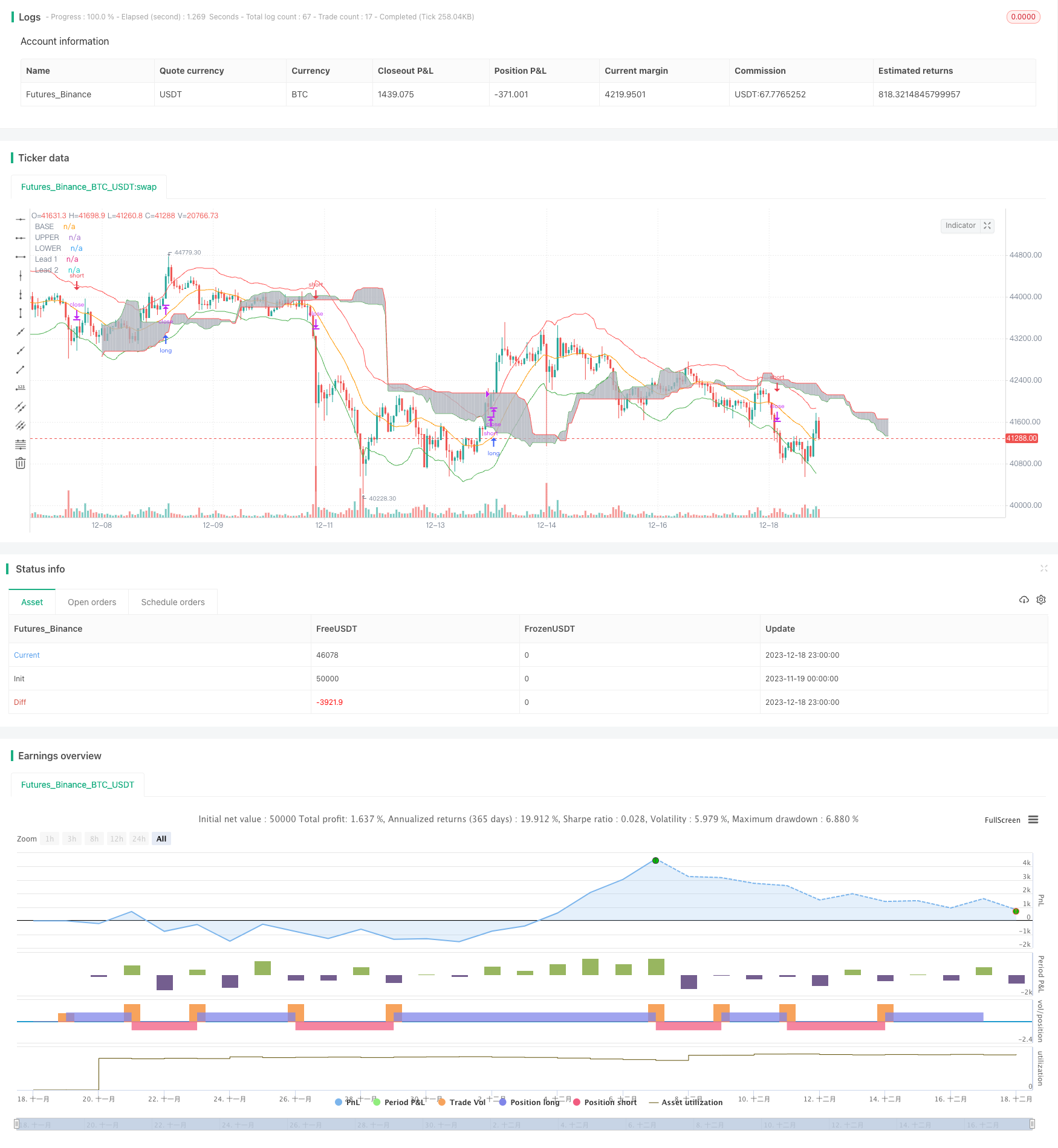이동평균 전략에 기초한 통합 이치모쿠 켈트너 거래 시스템
저자:차오장, 날짜: 2023-12-20 13:40:08태그:

전반적인 설명
이 전략은 이동 평균 전략, 이치모쿠 클라우드 차트 및 켈트너 채널 기술 지표를 통합하여 트렌드 추적 및 돌파구 거래를 달성하여 고주파 알고리즘 거래에 적합합니다.
전략 원칙
- Keltner 채널을 사용하여 주가가 채널의 상부 및 하부 레일을 초과하는지 판단하여 포지션을 개설하는 신호로 사용하십시오.
- 이치모쿠 클라우드 차트는 트렌드 방향을 판단하고 켈트너 채널을 사용합니다.
- 이동 평균 전략은 종료 신호를 보내
이점 분석
- 결정 정확성을 향상시키기 위해 포괄적 인 판단을 위해 여러 가지 기술 지표를 통합하십시오.
- 켈트너 채널은 포지션을 개설할 때 최고치를 추격하고 최저치를 제거하는 것을 피하기 위해 과소매와 과소매 조건을 판단합니다.
- 이치모쿠 클라우드 차트는 트렌드에 반하는 거래를 피하기 위해 주요 트렌드를 판단합니다.
- 이동 평균 전략은 충격을 필터링하고 과도한 민감성을 방지합니다.
위험 분석
- 여러 지표의 통합은 매개 변수 설정을 더 복잡하게 만들고 신중한 테스트를 요구합니다.
- 회전선과 클라우드 차트의 기본선의 교차는 항상 신뢰할 수 있는 거래 신호가 아닙니다.
- 켈트너 채널은 다른 조류의 특성에 적응하기 위해 매개 변수를 조정해야합니다.
최적화 방향
- 서버 성능을 평가하고 거래 빈도를 높이기 위해 이동 평균 주기를 적절히 단축합니다.
- 매개 변수에 대한 다른 주류의 감수성을 테스트하고 적응 매개 변수를 설정합니다.
- 단일 손실을 줄이기 위해 스톱 로스 전략을 강화
요약
이 전략은 트렌드 추적 및 효율적인 돌파 트레이딩을 달성하기 위해 이치모쿠 클라우드 차트, 켈트너 채널 및 이동 평균 전략을 여러 기술적 지표와 통합합니다. 단일 지표와 비교하면이 전략의 판단은 특정 잘못된 신호를 피하여 더 포괄적이고 정확합니다. 동시에 매개 변수 설정이 더 복잡하고 개별 주식에 최적화되어야한다는 문제도 있습니다. 일반적으로이 전략은 중요한 영향을 미치는 고주파 알고리즘 거래에 적합합니다.
/*backtest
start: 2023-11-19 00:00:00
end: 2023-12-19 00:00:00
period: 1h
basePeriod: 15m
exchanges: [{"eid":"Futures_Binance","currency":"BTC_USDT"}]
*/
//@version=3
// Author: Persio Flexa
// Description: Ichimoku Clouds with Keltner Channel, perfect for margin trading
strategy("Ichimoku Keltner Strategy", overlay=true)
// -- Keltner ------------------------------------------------------------------
source = close
useTrueRange = input(true)
length = input(18, minval=1)
mult = input(1.8)
ma = sma(source, length)
range = useTrueRange ? tr : high - low
rangema = sma(range, length)
upper = ma + rangema * mult
lower = ma - rangema * mult
plot(ma, title="BASE", color=orange,transp=85)
plot(upper, title="UPPER", color=red)
plot(lower, title="LOWER", color=green)
//crossUpper = crossover(source, upper)
//crossLower = crossunder(source, lower)
crossUpper = source > upper
crossLower = source < lower
bprice = 0.0
bprice := crossUpper ? high+syminfo.mintick : nz(bprice[1])
sprice = 0.0
sprice := crossLower ? low -syminfo.mintick : nz(sprice[1])
crossBcond = false
crossBcond := crossUpper ? true
: na(crossBcond[1]) ? false : crossBcond[1]
crossScond = false
crossScond := crossLower ? true
: na(crossScond[1]) ? false : crossScond[1]
cancelBcond = crossBcond and (source < ma or high >= bprice )
cancelScond = crossScond and (source > ma or low <= sprice )
// ---------------------------------------------------------------------
// -- Ichimoku
ATRlength = input(200, minval=1)
ATRMult = input(2.272, minval=1)
ATR = rma(tr(true), ATRlength)
len = input(26, minval=1, title="EMA Length")
src = input(close, title="Source")
out = ema(src, len)
emaup = out+(ATR*ATRMult)
emadw = out-(ATR*ATRMult)
conversionPeriods = input(15, minval=1),
basePeriods = input(35, minval=1)
laggingSpan2Periods = input(52, minval=1),
displacement = input(26, minval=1)
donchian(len) => avg(lowest(len), highest(len))
conversionLine = donchian(conversionPeriods)
baseLine = donchian(basePeriods)
leadLine1 = avg(conversionLine, baseLine)
leadLine2 = donchian(laggingSpan2Periods)
p1 = plot(leadLine1, offset = displacement, color=green,transp=85, title="Lead 1")
p2 = plot(leadLine2, offset = displacement, color=red,transp=85, title="Lead 2")
fill(p1, p2,silver)
longCond = crossover(conversionLine, baseLine)
shortCond = crossunder(conversionLine, baseLine)
// -------------------------------------------------------------------------
if (crossUpper and (conversionLine > baseLine))
strategy.entry("long", strategy.long, stop=bprice, comment="LONG")
if (crossLower and (conversionLine < baseLine))
strategy.entry("short", strategy.short, stop=sprice, comment="SHORT")
strategy.close("long", when = (shortCond and source < lower))
strategy.close("short", when = (longCond and source > upper))
더 많은
- RSI 거래 전략
- 토르트 트렌드 거래 시스템
- 다중 이동 평균 교차 거래 전략
- 유연한 MA/VWAP 크로스오버 전략 (Stop Loss/Take Profit)
- 볼링거 밴드 기반의 가격 행동 전략
- 이중 이동 평균 범주 파업 전략
- 이동평균선을 가진 격자 전략
- 이중 이동 평균 지능 추적 전략
- RSI-EMA 트렌드 브레이크 전략
- 피브 포인트 예측 오시레이터 백테스팅 전략
- 이중 추적 거북이 거래 전략
- 이치모쿠 킨코 히오 기반 BTC 거래 전략
- 전략에 따른 AO 지표 기반 트렌드
- 유니버설 저격수 전략
- 이중 지표 하이브리드 양적 거래 전략
- 볼링거 밴드 모멘텀 브레이크업 전략
- 볼링거 밴드 이동 평균에 기초한 단기 반전 양적 전략
- 그라디언트 MACD 양성 전략
- 이중 트랙 빠른 양적 역전 거래 전략
- 하이킨 아시와 카우프만 적응적인 이동 평균 거래 전략